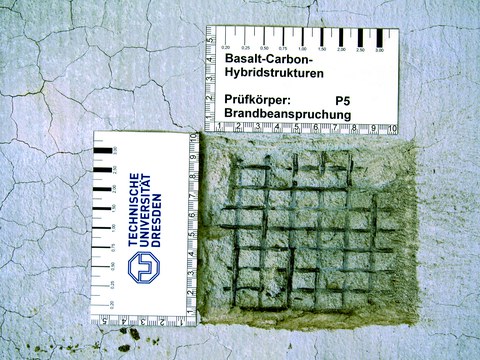Hochtemperaturbeständige Basalt-Carbon-Hybridstrukturen
Inhaltsverzeichnis
Projektdaten
|
Titel | Title |
Kurzbeschreibung
Das zentrale Ziel des Vorhabens besteht in der Entwicklung und Bereitstellung von Basaltbewehrungen für die nachträgliche Ertüchtigung und Verstärkung von Stahlbetonbauteilen. Dies erfordert eine anforderungsgerechte und applikationsorientierte Ausbildung von textiler Struktur und Beschichtung unter besonderer Berücksichtigung der Dauerhaftigkeit und des Brandschutzes sowie unter Einbeziehung der dazu notwendigen Weiterentwicklung der Bemessungswerkzeuge für die strukturmechanische und thermische Auslegung des basaltbewehrten Verbundwerkstoffes. Durch die Ausweitung der stofflichen Basis für die Bewehrungstextilien auf hochwertige Basaltfilamentgarne steht ein Material zur Verfügung, das aus einem in der Natur vorhandenem Gestein reproduzierbar hergestellt werden kann. Bei vergleichbaren Produktionskosten bietet es hinsichtlich seiner thermo-mechanischen Eigenschaften gegenüber alkaliresistentem Glas klare Vorteile. Dementsprechend sollte der resultierende zementgebundene Verbundwerkstoff gegenüber Textilbetonen mit alkaliresistenter Glasbewehrung eine höhere mechanische Leistungsfähigkeit und eine deutlich bessere thermische Beständigkeit zeigen. Darüber hinaus bietet die Kombination von Carbon- und Basaltgarnen in einer hybriden Bewehrung die Möglichkeit, bei hoher mechanischer Belastung des Bauteils vorwiegend in einer Richtung kostengünstigere Bewehrungstextilien mit vergleichbarem Hochtemperaturverhalten beider Garnmaterialien anzubieten. Während die hohen mechanischen Belastungen in der Tragrichtung durch die Carbongarne abgetragen werden, ist die erforderliche Mindestbewehrung zur Rissbreitenbegrenzung in allen anderen Richtungen durch die Basaltgarne sichergestellt. Im angestrebten Projekt gilt es daher, gitterartige Bewehrungen mit Verstärkungsfilamentgarnen ausschließlich aus Basalt sowie mit hybridem Aufbau aus Carbon- und Basaltfilamentgarnen zu realisieren und zu erforschen. Für den baupraktischen Einsatz ist zudem der Nachweis der dauerhaften Leistungsfähigkeit der Basaltgarne unerlässlich. Durch den nachträglichen Auftrag angepasster Beschichtungen auf die Garne bzw. Textilien soll ein zusätzlicher Schutz gegenüber dem alkalischen Milieu der Betonmatrix sowie eine bessere Hochtemperaturbeständigkeit geschaffen werden. Die Sicherstellung und der Nachweis einer verbesserten Alkalibeständigkeit des beschichteten Bewehrungstextiles ist ein weiteres, wesentliches Projektziel.
Bericht aus dem Jahrbuch 2012
Basaltfasern – eine Alternative für Textilbeton?
Bisher wurden verschiedene Hochleistungsfasern in Kombination mit Beton für den Einsatz für tragende Betonbauteile erforscht. Hochfeste Carbontextilien stehen momentan kurz vor der Markteinführung, sind aber derzeit noch relativ preisintensiv. Alkaliresistentes Glas, mit dem ebenfalls schon vielversprechende Ergebnisse erzielt worden sind, stößt sowohl unter Kosten- als auch unter Eigenschaftsaspekten in der
Bauindustrie auf Vorbehalte, z. B. hinsichtlich der Dauerhaftigkeit im Beton und der Temperaturbeständigkeit, was beim baulichen Brandschutz relevant ist.
Bereits seit längerem wird deshalb immer wieder der Einsatz von Basaltfasern in Betracht gezogen. Diese weisen mit 500 °C eine ähnliche Temperaturbeständigkeit wie Carbonfasern auf. Der Einsatz der Basaltfasern scheiterte bisher jedoch an der unzureichenden bzw. schwankenden Qualität und Alkaliresistenz der Fasern, aber auch an deren eingeschränkter Verfügbarkeit.
Die Entwicklung industrietauglicherer Herstellprozesse für Basaltfasern bewirkte aber mittlerweile, dass nun Basaltfasern potenziell in sehr großen Mengen zur Verfügung stehen. Im Vergleich zu AR-Glas sind sie ca. 20 – 40 % preiswerter und gleichzeitig um etwa 15 % zugfester. Fragen zur industriellen Verarbeitbarkeit und Beschichtung, zum Widerstand im Brandfall sowie zur Dauerhaftigkeit und zum Verbundverhalten bei Kombination mit Beton sind jedoch weitgehend ungeklärt. Deshalb ist das primäre Ziel dieses Forschungsvorhabens die Entwicklung und Bereitstellung hochtemperaturbeständiger Basaltbewehrungen zur nachträglichen Verstärkung vorhandener Bausubstanz mit Fokus auf eine anforderungsgerechte und applikationsorientierte Ausbildung der Textilien und deren Beschichtung unter Beachtung der Anforderungen an Dauerhaftigkeit und Brandschutz.
Stationäre und instationäre Dehnkörperversuche bei Temperaturen bis 600 °C sollen Erkenntnisse zur Tragfähigkeit und zum Spannungs-Dehnungs-Verhalten liefern. Pull-Out-Tests unter Temperaturbelastung dienen der Bestimmung von Verbundkennwerten zwischen Filamentgarn und Feinbetonmatrix und geben Aufschlüsse über erforderliche Verankerungs- und Übergreifungslängen. Durch thermogravimetrische Analysen und Warmkriechversuche an der textilen Bewehrung sollen zudem Aussagen über den Masseverlust und das Verformungsverhalten gewonnen werden. Großformatige Bauteilversuche mit Beflammung bilden den Projektabschluss.
Bericht aus dem Jahrbuch 2014
Basaltfasern für temperaturbeständigen Textilbeton

Freigelegte Basaltbewehrung nach Brandbeanspruchung
Mit den extrem festen Carbonfasern steht ein sehr leistungsfähiges Bewehrungsmaterial für Textilbetonkonstruktionen zur Verfügung, das relativ kostenintensiv aber robust und nicht anfällig gegenüber dem alkalischen Milieu im Beton ist. Bewehrungen auf Basis von AR-Glasfasern sind etwas kostengünstiger, haben aber Nachteile im Hinblick auf die Tragfähigkeit und Dauerhaftigkeit. Auch Basalt ist als Bewehrungsmaterial denkbar. Gegenüber den anderen Materialien hat Basalt den Vorteil, dass er in großer Menge natürlich vorkommt. Im Rahmen des Projekts sollte ein hochtemperaturbeständiger, mit Basalt bewehrter Verbundwerkstoff zur nachträglichen Verstärkung und Instandsetzung von vorhandener Bausubstanz aus Stahlbeton entwickelt werden. Zur Box wechseln Bearbeiten
Die mechanischen Untersuchungen an Textilbetonproben mit beschichteten Basalttextilien als Bewehrung zeigten eine recht ordentliche Performance. Die Tragkraft lag etwas über der von AR-Glastextilien. Das Verbundverhalten entspricht den AR-Glastextilien, damit wird eine kurze Verankerungslänge und eine gute Rissverteilung erreicht.
Um Basalttextilien unter den gewünschten Rahmenbedingungen einsetzen zu können, wird aber weiterhin eine hochtemperaturbeständige Beschichtung benötigt, die die Dauerhaftigkeit gewährleisten und die Anforderungen des Brandschutzes erfüllen muss. Bei einer Brandbeanspruchung verliert Basalt, wie auch AR-Glas und Betonstahl, schon bei relativ geringen Temperaturen ab ca. 150 °C deutlich an Festigkeit. Deshalb müssen auch die Basaltgarne vor höheren Temperaturen geschützt werden, um eine nennenswerte statische Lastabtragung im Brandfall gewährleisten zu können. Von Vorteil ist, dass die Basalttextilien in der Lage sind, eine vorhandene Verstärkungsschicht auch unter hohen Temperaturen zusammenzuhalten. Betonabplatzungen waren in den Brandversuchen marginal, die wärmedämmende Wirkung einer Verstärkungsschicht für die Grundkonstruktion wurde aufrechterhalten. Als konstruktive und Risse verteilenden Bewehrung kann Basaltbewehrung auch bei Brandbeanspruchung also vorteilhaft eingesetzt werden.
Die getesteten Basaltmaterialien waren allerdings noch nicht ausreichend alkaliresistent, weshalb hier noch Forschungsbedarf besteht, geeignete Lagerstätten sollen verfügbar sein. Denkbar ist aber bereits jetzt der Einsatz dann, wenn die mangelnde Alkaliresistenz von untergeordneter Bedeutung ist, bspw. in extrem trockener Umgebung oder auch bei Bauteilen mit einer zeitlich begrenzten Nutzungsdauer.
